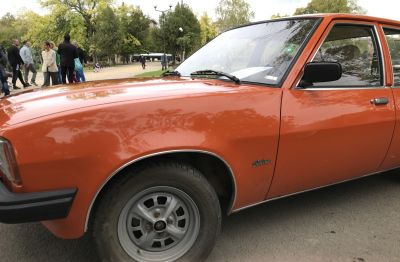 1999 Ford Focus I Sedan Dimensions, Size & Specs
1999 Ford Focus I Sedan Dimensions, Size & SpecsMeasurements of the 1999 Ford Focus I Sedan, engineered for optimal performance and comfort
| Dimensions | |
|---|---|
| Length: | 4362-4369 mm171.7-172.0 in14.3-14.3 ft |
| Width: | 1702 mm67.0 in5.6 ft |
| Height: | 1430-1481 mm56.3-58.3 in4.7-4.9 ft |
| Trunk Capacity: | 490 liter17.3 cu ft |
| Weight Specifications | |
| Curb Weight: | 1091-1300 kg2405-2866 lbs |
| Maximal permitted Weight: | 1595-1725 kg3516-3803 lbs |
| Tire Specifications | |
| Rims Sizes: | 108-inch rims:
|
| Tire Sizes: |
|
The first-generation Ford Focus Sedan, produced from 1998 to 2005 and introduced in the 1999 model year, set a benchmark in the compact car segment with its balanced proportions and practical interior space. Measuring between 4362 mm to 4369 mm (171.7 to 171.9 inches) in length, the Focus I Sedan offers a compact footprint ideal for urban driving while providing a comfortable cabin. Its width ranges from 1698 mm to 1702 mm (66.8 to 67 inches), contributing to a stable road presence, and its height varies from 1430 mm to 1481 mm (56.3 to 58.3 inches), offering a low yet roomy silhouette.
The curb weight of this sedan spans from 1091 kg to 1300 kg (2405 to 2866 lbs), depending on configuration and trim, balancing efficiency with solid build quality. Maximum allowable weight ranges between 1595 kg and 1725 kg (3516 to 3802 lbs), indicating its capacity for various passenger and cargo loads. Speaking of cargo, the Ford Focus I Sedan provides a generous luggage capacity of 490 liters (17.3 cubic feet), making it practical for daily commuting and weekend trips alike.
Wheel options include rim sizes from 14 to 15 inches, with standards like 5.5Jx14 ET47.5 4x108 and 6Jx15 ET50 4x108 variants. Tire sizes matched to the rims range from 175/70 R14 to 195/60 R15, offering drivers choices depending on driving preferences and conditions. This generation's design and engineering not only prioritized size efficiency but also aimed to deliver a dynamic driving experience characteristic of Ford vehicles.
Overall, the Ford Focus I Sedan is a notable entry in the compact sedan market, blending practical dimensions, manageable weight, and solid load capacity, making it a practical and reliable choice for drivers seeking everyday usability along with classic Ford driving dynamics.
Discover the standout features that make the 1999 Ford Focus I Sedan a leader in its class
Have a question? Please check our knowledgebase first.
The Ford Focus I Sedan from 1999 measures between 4362 mm and 4369 mm (approximately 171.7 to 172.0 inches) in length. For sedans produced in that era, this range is quite typical, placing the Focus in the compact car category. Its length supports a balanced combination of interior space and maneuverability, suitable for urban and suburban driving environments. Compared to larger mid-size sedans, the Focus was slightly shorter, aiding in easier parking and handling while maintaining reasonable cabin and trunk room.
The width of the 1999 Ford Focus I Sedan ranges from 1698 mm to 1702 mm (about 66.85 to 67.0 inches). This width is fairly standard for compact sedans of its class and era, providing a good balance between exterior footprint and interior comfort. The width contributes positively to both the stability of the vehicle on the road and the shoulder room for passengers inside. It allows for a comfortable three-across seating arrangement in the rear while maintaining practical driving dynamics for everyday use.
The Ford Focus I Sedan’s height varies from 1430 mm to 1481 mm (approximately 56.3 to 58.3 inches). This height supports sufficient headroom for average adult passengers, enhancing comfort over longer drives. The slightly lower height compared to taller sedans also contributes to improved aerodynamic performance, potentially improving fuel efficiency and reducing wind noise at higher speeds. The varied height range results from different trim levels and possible suspension setups, affecting overall ride height and stance.
The curb weight of the 1999 Ford Focus I Sedan spans from 1091 kg to 1300 kg (approximately 2404 to 2866 lbs). This moderate weight range positions the vehicle as light enough to promote responsive handling and agility, especially suited to urban and highway driving. In terms of fuel efficiency, this weight allows the Focus to achieve competitive consumption figures compared to heavier sedans, contributing to its appeal as an economical daily driver. Weight variations are often due to differing equipment levels, engine options, and trim.
The maximum weight or gross vehicle weight (GVW) for the Ford Focus I Sedan ranges between 1595 kg and 1725 kg (approximately 3516 to 3802 lbs). This figure includes the vehicle's curb weight plus passengers, cargo, fuel, and optional equipment. Adhering to this limit is essential for safe driving, preventing overloading-related issues such as compromised braking, suspension strain, and poor handling. This weight capacity supports the vehicle in comfortably carrying four to five passengers along with luggage, making it versatile for everyday and long-distance use.
The Ford Focus I Sedan offers a luggage capacity of 490 liters (approximately 17.3 cubic feet). This trunk size is quite generous for a compact sedan, capable of accommodating several medium-sized suitcases or grocery loads. For family use, the space suffices for weekend trips or daily errands, providing practicality without the bulk of larger sedans or SUVs. The well-shaped trunk opening and low lift-over height also enhance usability, making loading and unloading easier during travel or routine activities.
Yes, the 1999 Ford Focus I Sedan comfortably fits into a standard residential garage. Typical single-car garage dimensions average around 3 meters (approx. 9.8 feet) in width and 5.5 to 6 meters (approximately 18 to 20 feet) in length. Given the Focus's length of roughly 4.36 meters (14.3 feet) and width close to 1.7 meters (5.6 feet), it provides ample clearance for easy parking and maneuvering space within the garage. Its relatively compact size compared to larger vehicles also allows for additional storage or workspace around the vehicle inside the garage.
The Ford Focus I Sedan replaced the Ford Escort, and in terms of dimensions, it saw notable changes. Generally, the Focus grew slightly longer and wider, with lengths around 4362-4369 mm versus the Escort's typically shorter length, enhancing interior space and road presence. The Focus also improved in height and Gaussian weight ranges, making it more robust and accommodating. These dimensional increases supported better passenger comfort, larger luggage capacity, and modernized styling, marking a significant step forward in Ford's compact sedan evolution.
When compared to contemporaries like the 1999 Honda Civic and Toyota Corolla, the Ford Focus I Sedan holds its own dimensionally. The Focus's length of around 4362-4369 mm (171.7-172.0 inches) is slightly longer than those models, which typically measured near 4400 mm but varied by version. Width at approximately 1700 mm also matches or slightly exceeds competitors, providing competitive interior spaciousness. Height variation of 1430-1481 mm is similar to rivals, balancing headroom and aerodynamics. Such dimensions give the Focus a spacious yet manageable footprint, appealing to buyers seeking practicality combined with modern styling.
The 1999 Ford Focus I Sedan came with a variety of rim and tire sizes to suit different trims and preferences. Rim sizes included 5.5Jx14 with ET47.5 or ET43.5 offset, and 6Jx15 ET50, all with a 4x108 bolt pattern. Tire sizes ranged from 175/70 R14 to 195/60 R15. These options balanced ride comfort, handling, and road grip. Smaller rims with higher profile tires generally improve ride smoothness and durability, while larger rims with lower profile tires can enhance steering response and aesthetics. This range offered owners flexibility depending on driving style or local road conditions.
Discover similar sized cars.

| Model Year: | 1979 |
|---|---|
| Length: | 4321 mm170.1 in |
| Width: | 1670 mm65.7 in |
| Height: | 1380 mm54.3 in |

| Model Year: | 1976 |
|---|---|
| Length: | 4321 mm170.1 in |
| Width: | 1670 mm65.7 in |
| Height: | 1380 mm54.3 in |

| Production: | 2011-2015 |
|---|---|
| Model Year: | 2011 |
| Length: | 4370 mm172.0 in |
| Width: | 1700 mm66.9 in |
| Height: | 1470 mm57.9 in |

| Production: | 1990-2001 |
|---|---|
| Model Year: | 1990 |
| Length: | 4355 mm171.5 in |
| Width: | 1695 mm66.7 in |
| Height: | 1445 mm56.9 in |

| Production: | 1990-1996 |
|---|---|
| Model Year: | 1990 |
| Length: | 4354 mm171.4 in |
| Width: | 1695 mm66.7 in |
| Height: | 1445 mm56.9 in |

| Production: | 2006-2014 |
|---|---|
| Model Year: | 2006 |
| Length: | 4342 mm170.9 in |
| Width: | 1692 mm66.6 in |
| Height: | 1435 mm56.5 in |

| Production: | 2018-present |
|---|---|
| Model Year: | 2018 |
| Length: | 4342 mm170.9 in |
| Width: | 1692 mm66.6 in |
| Height: | 1435 mm56.5 in |

| Production: | 2019-2022 |
|---|---|
| Model Year: | 2020 |
| Length: | 4340 mm170.9 in |
| Width: | 1983 mm78.1 in |
| Height: | 1470 mm57.9 in |
